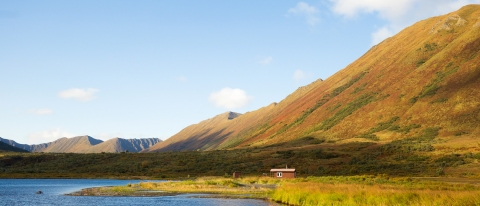Visit Us
Visiting Kodiak National Wildlife Refuge can be the experience of a lifetime! It offers superb wildlife viewing, hunting, hiking, kayaking, fishing, birding, and camping. The 1.9 million acre Refuge can only be reached by boat or floatplane, and Kodiak weather is variable, so planning ahead (including being prepared to stay longer than expected) is important.
Visitor Center
We invite you to visit us to learn more about Kodiak wildlife and ecosystems in our exhibit hall, be amazed by the complete skeleton of a 36 foot Gray Whale, or catch a summer interpretive talk by our park rangers. Maps and pamphlets, including an island bird list, are available at the information desk, and we also have an award-winning 12 minute film about the refuge available for screening on demand. Our partner bookstore, Alaska Geographic, offers natural history-themed books, cards, gifts and educational curios and a portion of all sales directly support Refuge education and outreach programs. You can now also visit the Kodiak Refuge Visitor Center virtually. We invite you to take this 3D interactive tour!
Public Use Cabins
Cabins are a wonderful way to enjoy the Refuge and access excellent fishing and hunting areas. Kodiak Refuge's ten public use cabins are are accessible via boat or floatplane and equipped with oil stoves for heating, pit-style toilets and separate meat caches (cabins do not have electricity, plumbing, or cookstoves). Learn about and reserve a cabin at Recreation.gov.
HEATING: Most cabins are equipped with Nordic-brand stoves for heating. They can burn kerosene, heating oil, or automotive diesel (never use gasoline, Blazo, Coleman fuel, or similar products). 1-3 gallons per day is usually sufficient. Be sure to use heating stoves according to posted directions.
CLEANUP: Haul out ALL trash, unused food, and fuel cans. NEVER bury garbage. Buried garbage may attract bears and create a safety hazard for you and/or future visitors.
Bear Safety
Areas in Kodiak National Wildlife Refuge host some of the densest populations of brown bears in the world. Before you visit the Refuge, or anywhere else you might encounter a bear, familiarize yourself with these essentials for traveling in Alaska's bear country and watch this Bear Spray Training video.
If you are already in Kodiak, stop by the Visitor Center to take advantage of our many FREE bear safety resources:
- Borrow an electric bear fence to keep bears out of your camp
- Borrow a bear-proof food storage container (3 sizes available)
- Watch the film Staying Safe in Bear Country
- Speak to our knowledgeable staff for bear safety recommendations specific to your trip
Activities
Youth Education Programs
Salmon Camp
The mission of Salmon Camp is to educate Kodiak’s youth about the natural and cultural systems that define Kodiak’s geography and empower learners to investigate their own connections to this special place through hands-on learning, self-reflection and group discovery.
Contact Natalie Fath.
FUN Program
Program currently on pause
WILD Program
Program currently on pause
The Wildlife, Investigation, Learning, and Discovery (WILD) program is designed for ages 6-12. There is a new theme each time the program is offered.
Visitor Center Youth Activities
Drop in to the Visitor Center anytime during open hours to earn a Junior Ranger patch, do a scavenger hunt, or check out a FUN backpack.
Contact 907-308-3966 to learn more.
Locations
Refuge Visitor Center
Stop by to visit us and learn more about Kodiak wildlife and ecosystems in our exhibit hall, be amazed by the complete skeleton of a 36 foot Gray Whale, or catch a summer interpretive talk by our park rangers. Maps and pamphlets, including an island bird list, are available at the information desk, and we also have an award-winning 12 minute film about the refuge available for screening on demand. Our partner bookstore, Alaska Geographic, offers natural history-themed books, cards, gifts and educational curios. You can now also visit the Kodiak Refuge Visitor Center virtually. We invite you to take this 3D interactive tour!
Refuge Headquarters
Refuge Headquarters is the administrative site for Kodiak National Wildlife Refuge, but there's still plenty for visitors to see and do at this location!
- Check out the Little Free Library, located outside the front door, to pick out an environmental or conservation themed book.
- Pack a lunch and head to our overlook for a spectacular view of the forest and ocean.
- Follow the signs to explore our connector trails through the lush spruce forest to Buskin Beach, Boy Scout Lake, and many more places.
From Kodiak city take Rezanof Drive south towards the airport and Coast Guard Base. Take a left on Buskin River Road and then the first left at the Kodiak National Wildlife Refuge sign.








